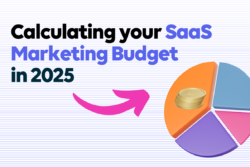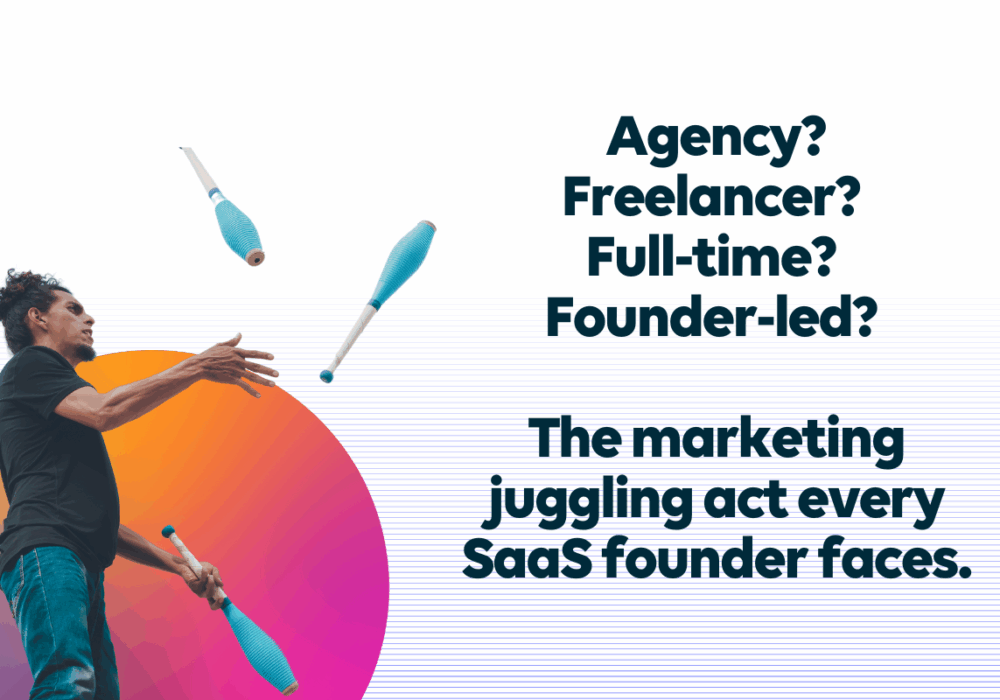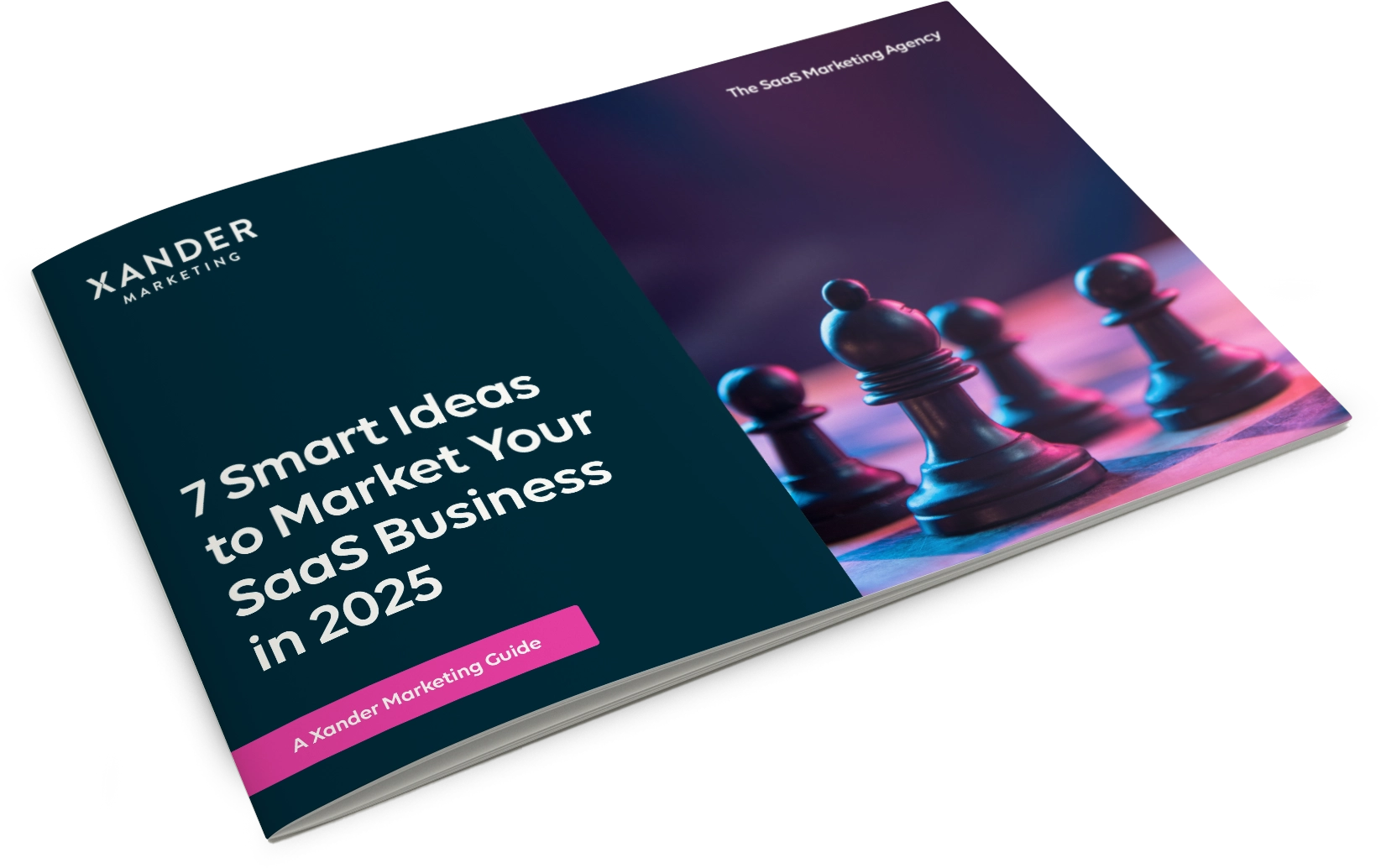How Much Should Your SaaS Marketing Budget Be in 2025?
7th May 2025

Whether you’re launching a new SaaS startup or leading an established player in the industry, you likely have ambitious growth plans for your business. While having bold goals is essential, turning them into reality requires a clear, realistic marketing budget. Without proper financial planning, even the most innovative marketing strategies can become financially unsustainable.
As economic pressures continue to influence business decisions in 2025, creating a well-structured marketing budget has never been more crucial. The question remains: how much should you allocate to marketing your SaaS product?
Developing a B2B SaaS marketing budget goes far beyond simple calculations. It requires a deep understanding of your business stage, growth objectives, target market, and the unique dynamics of the SaaS business model.
In this comprehensive guide, we’ll examine the latest data on SaaS marketing benchmarks, explore how budgets vary by company stage, and provide practical frameworks to help you determine the right marketing investment for your specific situation.
SaaS Marketing Budget Benchmarks for 2025
Let’s start with the current industry benchmarks to establish a baseline for your planning.
Average Marketing Spend as a Percentage of Revenue
A recent survey of private SaaS firms shows that B2B SaaS companies typically allocate around 8-10% of their annual revenue to marketing. According to the data, the median marketing spend is approximately 8% of Annual Recurring Revenue (ARR), down slightly from about 10% in previous years as companies have tightened expenses.
However, this median figure masks significant variations based on company stage, funding status, and growth objectives:
Early-stage startups: Often invest very aggressively in marketing, sometimes exceeding 100% of revenue (operating at a planned loss) to drive initial growth. Seed-stage SaaS firms frequently pour 20-40% or more of revenue into marketing when rapid customer acquisition is the priority.
Scaling/mid-stage companies: Typically allocate 10-30% of revenue to marketing. As these companies grow, they maintain substantial marketing investments while gradually improving efficiency.
Late-stage/mature businesses: Generally reduce marketing spend to 5-15% of revenue. Established SaaS businesses running efficiently might keep marketing to single-digit percentages to preserve margins.
Funding status matters: Venture-backed SaaS startups spend approximately 58% more on marketing (as a percentage of revenue) than their bootstrapped counterparts. In fact, VC-backed startups typically allocate roughly double the share of revenue to marketing compared to self-funded companies.
Jason Lemkin of SaaStr aptly summarises: “Startups that are scaling are spending about 10% of revenue on marketing (and trending up).”
Marketing Budget by Company Size/Stage (Actual Figures)
Beyond percentages, it’s helpful to understand typical marketing budgets in absolute terms:
Seed/Early-Stage Startups (Pre-PMF or <£2M ARR):
- Marketing spend typically ranges from tens to low hundreds of thousands of pounds or dollars annually
- A startup at ~£1M ARR might spend 20-40% of revenue on marketing
- Venture-funded seed startups might burn $1M+ annually on marketing despite minimal revenue
- Bootstrapped startups may cap marketing spend under £100K until revenue increase
Mid-Stage Scaleups (£5M-£20M ARR):
- Annual marketing budgets often reach high six or seven figures
- A company with £5-10M ARR might allocate 10% to marketing
- Fast-growing scaleups might invest 15-20%, pushing annual spend toward £1.5-£2M+
- A SaaS business with ~£3-5M ARR typically spends around £210K-£350K on marketing (at ~7% median)
Larger/Late-Stage Private SaaS (£20M+ ARR):
- Marketing budgets enter the multi-million pound range
- At £20M ARR, a 10% allocation means ~$2M for marketing
- At £50M ARR, marketing spend might reach 10% or even 15-20% for companies aiming for category leadership
- Public SaaS companies invest tens of millions in marketing, though as a percentage of revenue this may stabilise in the mid-single digits to low teens
Marketing Budget Allocation: Where Does the Money Go?
How SaaS companies distribute their marketing budget across different activities is just as important as the total amount. While allocations vary by strategy, a typical breakdown for B2B SaaS companies in 2025 includes:
People (Internal Marketing Team): 45-55% of the budget
- Salaries, benefits, and contractors
- Marketing is human-capital intensive; nearly half of spending supports the team executing campaigns
Demand Generation & Paid Media: 15-20% of the budget
- Paid advertising (PPC search ads, paid social)
- Account-based marketing (ABM)
- Outbound email campaigns
- SEO efforts
Content Marketing: 5-7% of the budget
- Creating blog articles, ebooks, videos, etc.
- Content promotion and distribution
- Early-stage startups often allocate more to content (20-40%) as it drives inbound leads
Marketing Software & Tools: 4-6% of the budget
- CRM and marketing automation platforms
- Analytics tools
- SEO and PPC management software
- Website CMS and hosting
Product Marketing & Branding: 8-10% of the budget
- Customer advocacy programs
- Market research
- Sales enablement collateral
- Messaging and positioning work
Events and PR: 3-5% of the budget (optional)
- Industry events and trade shows
- PR agency support
- Press releases and media outreach
Channel Distribution: Early-Stage vs. Mid-Stage SaaS
The focus of marketing spend typically evolves as companies grow:
| Marketing Channel | Early-Stage Startup | Mid-Stage Startup |
|---|---|---|
| Paid Search Ads | 10-20% | 10-30% |
| Content Marketing | 20-40% | 10-20% |
| PR & Outreach | 10-20% | 5-15% |
| Conferences & Events | 10-20% | <10% |
| Website & Funnel Optimisation | 10-20% | 10-20% |
Early-stage companies often emphasise content marketing (20-40% of program dollars) to build an audience and establish inbound traffic. As companies scale, they typically shift toward more scalable paid acquisition channels, reducing content’s share to 10-20% while increasing paid search spending.
US vs. UK SaaS Marketing Spend Differences
While SaaS marketing budgets follow similar patterns globally, there are some notable differences between US and UK companies:
Budget as a Percentage of Revenue:
- UK B2B tech companies actually spend slightly more of their revenue on marketing than US counterparts
- In 2024, UK tech/SaaS sector averaged about 10% of revenue on marketing
- US tech firms averaged around 9%
Spending Recovery and Trends:
- The UK saw a rebound in marketing spend heading into 2025
- In-person events saw the largest increase in the UK (+12.3% budget growth)
- PR budgets also rose (+6.8%)
US Budget Trajectory:
- Marketing budgets are trending upward after prior cuts
- Overall marketing spend rose from 2.6% of company revenue in late 2023 to about 5.8% in late 202
- Digital marketing investments are increasing rapidly: digital spend grew from 7.9% to 11.1% (as share of revenue)
Cultural and Strategic Differences:
- UK startups often operate with leaner teams/budgets initially
- Silicon Valley startups tend to spend more aggressively early with venture backing
- US SaaS companies at the 0-20 employee stage spend nearly 2× more per employee on software/tools than UK companies
- As companies scale, spending levels converge between regions
Why Do SaaS Companies Invest Heavily in Marketing?
The SaaS business model has unique characteristics that influence marketing budgets:
- The Subscription Revenue Model SaaS companies operate under significant pressure to grow recurring revenues. They often make substantial investments in Customer Acquisition Cost (CAC) that pay for themselves gradually over the customer’s lifetime. The goal is to recoup acquisition costs before churn catches up.
- Long-Term Value Generation Unlike one-time purchases, SaaS customers generate value month after month. This allows for higher upfront acquisition spending, provided the lifetime value justifies it. SaaS marketing budgets must balance significant CAC with ongoing efforts to retain customers for the long term.
- Competitive Landscape The SaaS market has become increasingly crowded. Standing out requires substantial investment in brand building, content marketing, and targeted campaigns. This competitive pressure drives marketing spend upward, especially for companies aiming to become category leaders.
- Growth Expectations Investors in SaaS companies (particularly VC-backed ones) expect rapid growth. Meeting these expectations often requires significant marketing investment, especially in the early stages. As Jason Lemkin notes, “The reality is even in the age of AI, to acquire more customers, you have to keep spending more… as you saturate a market, finding that incremental customer often gets harder, not easier.”
SaaS Marketing Budget Formulas and Methodologies
Several approaches can help you determine an appropriate marketing budget:
1. Percentage of Revenue Method
The simplest approach is allocating a percentage of your current or projected revenue to marketing:
- 10% of revenue is considered a safe option for median growth
- 15-20% for accelerated growth
- 20-40% for aggressive growth phases
For example, a company with £5M in ARR aiming for moderate growth might allocate £500K (10%) to marketing.
2. Growth Delta Method
This approach bases the marketing budget on the difference between current revenue and target revenue:
- Calculate your growth delta (target revenue minus current revenue)
- Allocate 40% of this delta to marketing
For example, a company with £1.5M in ARR that wants to reach £4M would have a growth delta of £2.5M. Using the 40% rule, the marketing budget would be £1M.
3. Customer Acquisition Method
This method works backwards from your sales goals:
- Determine how many new customers you need
- Calculate how many leads are required based on conversion rates
- Estimate the cost per lead
- Multiply to determine total budget
For example:
- Goal: £400K in new sales
- Average customer value: £1K
- Required new customers: 400
- Sales closing rate: 20% (1 in 5)
- Required opportunities: 2,000
- Average cost per opportunity: £50
- Marketing budget needed: £100K
4. The LTV Ratio Approach
This method optimises budget based on the relationship between customer lifetime value and acquisition cost:
- Target an LTV ratio of 3:1 (the “golden ratio” for SaaS)
- Calculate the maximum allowable CAC based on your average LTV
- Determine marketing budget based on target customer acquisition numbers
For example, if your average LTV is £1,000, your target CAC should be around £333 to maintain the 3:1 ratio. If you aim to acquire 100 new customers, your marketing budget would be approximately £33,300.
How to Create Your Unique Marketing Budget in 2025
While industry benchmarks provide valuable context, your marketing budget must reflect your specific business circumstances:
- Assess Your Current Position
- Current ARR or revenue
- Growth rate and trajectory
- Available funding or cash reserves
- Marketing performance to date
- Competitive landscape
- Define Clear Objectives
- Revenue growth targets
- Customer acquisition goals
- Market share objectives
- New market entry plans
- Product launch timelines
- Evaluate Your Marketing Maturity
- Existing marketing team and capabilities
- Technology infrastructure
- Content assets and brand visibility
- Channel performance data
- Historical CAC and conversion metrics
- Consider Economic Factors
- Market conditions and trends
- Funding environment
- Customer spending patterns
- Competitive pressure
- Align with Business Strategy
- Growth vs. profitability focus
- Expansion plans
- Product roadmap
- Investor expectations
- Build Flexibility into Your Budget
- Set aside 10-15% for experimentation
- Create contingency plans for underperforming channels
- Allow for quarterly reassessment and reallocation
- Budget for responding to competitive moves
Budget Implications of Current Market Trends
Several trends are influencing SaaS marketing budgets in 2025:
- Tighter Budgets, Higher ROI Expectations Gartner’s research shows marketing budgets fell from 9.1% to 7.7% of company revenue from 2023 to 2024. Only 24% of CMOs felt they had sufficient budget to execute their strategy. This “do more with less” environment means every dollar must be justified by data or clear returns.
- AI Integration and Automation AI-powered tools are becoming line items in marketing budgets, from content automation to AI-driven analytics. Many firms are reallocating spend into AI solutions to stretch their dollars, using technology to improve efficiency across channels.
- Return of In-Person Events After years of virtual-only interactions, live events and conferences are making a comeback. Many B2B SaaS marketers are increasing event budgets to reconnect with prospects in person and create memorable brand experiences.
- Focus on Existing Customer Revenue With new customer acquisition becoming more expensive, there’s increased emphasis on marketing to existing customers. Budget allocations for customer marketing, expansion revenue campaigns, and retention initiatives are growing.
- Community-Led Growth Building and nurturing user communities has become a standard practice for SaaS companies. This relatively low-cost approach can drive word-of-mouth growth and reduce dependence on paid acquisition.
Practical Tips for Optimising Your SaaS Marketing Budget
Regardless of your budget size, these strategies can help maximise your marketing impact:
- Prioritise High-ROI Channels Analyse performance data to identify your most efficient channels. Double down on what works while carefully testing new approaches.
- Balance Short-Term and Long-Term Investments Allocate budget to both quick-win tactics (like paid ads) and long-term assets (like SEO and content) that deliver compounding returns.
- Leverage Marketing Technology Invest in tools that improve efficiency and measurement. Marketing automation, analytics platforms, and AI tools can help stretch your budget further.
- Implement Rigorous Testing and Optimisation Set aside budget specifically for A/B testing across channels. Small improvements in conversion rates can significantly impact overall marketing efficiency.
- Consider the In-House vs. Outsourced Mix Evaluate whether building an in-house team, hiring freelancers, or partnering with a specialised agency delivers the best value. Many companies use a hybrid approach, keeping strategic functions in-house while outsourcing specialised execution.
- Review and Reallocate Regularly Make budget adjustments quarterly based on performance data. Be willing to shift resources from underperforming channels to those showing stronger results.
- Invest in Analytics and Attribution Allocate budget for proper measurement and attribution. Understanding exactly which activities drive results allows for more intelligent spending decisions.
Finding Your SaaS Marketing Budget Sweet Spot
As your SaaS business evolves, your marketing budget will grow and change with it. Recent trends suggest:
- 8-10% of revenue as a baseline for steady growth
- 15-20% for accelerated growth
- 20-40% for aggressive growth phases
We recommend a marketing investment between 8% and 20% of your annual recurring revenue (ARR) for most B2B SaaS companies, depending on your growth objectives and business stage. This level of investment balances growth potential with financial sustainability.
Remember that your marketing budget isn’t just about how much you spend – it’s about how strategically you allocate those resources. Understanding industry benchmarks is a valuable starting point, but your final budget must reflect your unique business circumstances, growth ambitions, and market position.
Need Help Optimising Your SaaS Marketing Strategy?
A critical question when planning your marketing budget is whether to build capabilities in-house, hire freelancers, or partner with a specialised agency. Each approach has different cost implications and benefits.
With over 16 years of experience partnering with B2B SaaS businesses, Xander Marketing helps companies develop and execute marketing strategies that maximise returns on every pound or dollar invested. We understand the unique challenges of SaaS marketing and can help you:
- Create a data-driven marketing strategy aligned with your budget
- Identify the highest-impact channels for your specific business
- Implement campaigns that drive measurable growth
- Scale your marketing efforts efficiently as your business grows
Whether you have no in-house marketing team or need specialised support for your existing marketing manager, we can help you achieve your growth goals cost-effectively.
Get started with your free 30-minute consultation to discuss how we can optimise your marketing approach for 2025 and beyond.





